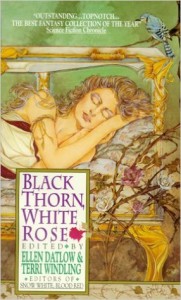 Laurie Thayer penned this review.
Laurie Thayer penned this review.
In Black Thorn, White Rose, Ellen Datlow and Terri Windling reteam to bring us a second collection of fairy tales meant for adult readers. As in their previous collection, Snow White, Blood Red, these are not the fairy tales that you might remember from childhood. The book begins with an introduction written by the editors, which touches on the fact that many of the original tales were in fact quite dark and grim. For instance, how many modern readers will know that in the original tale of Cinderella collected by the Brothers Grimm, there was no fairy godmother, no glass slipper? How many will know that the stepsisters, at their mother’s urging, mutilated themselves to fit into Cinderella’s lost shoe and were given away by the blood that trailed along behind them? How many will know that at the end of the story, the sisters were blinded by birds as punishment for their wickedness toward their stepsister? If you are only familiar with the Walt Disney version, you won’t know any of this.
In the original stories the heroes and heroines often faced death and despair, but won through to find happiness in the end. The wicked were never left unpunished, and the means of their punishments were often horrific: such as in the tale of “The Goose Girl,” in which the chamber maid who usurps the princess’s place is stripped naked, tossed in a barrel studded with nails, and dragged through the streets of the city by horses until she is dead, or the stepmother in “Snow-White and the Seven Dwarfs” who has to dance in red-hot iron shoes until she falls down dead.
This collection includes stories by Jane Yolen, Midori Snyder, Roger Zelazny, Patricia C. Wrede and other fine writers. As in the first book, a recommended reading list follows the stories, so that if you choose to investigate further in the field of wonder tales, you have places to go.
Among the offerings in this edition is Patricia C. Wrede’s “Stronger Than Time,” a version of the Sleeping Beauty tale in which the prince is not all that he appears. The story is told from the point of view of an old woodcutter who, because of his occupation, is always passing near to the tower in which the princess sleeps. He tries to warn off the young man who appears at his door asking for his help, but fails and finds himself cutting his way through thebriars to get the prince into the castle. But it is not the prince who awakens the sleeping princess….
Daniel Quinn’s “The Frog King, or Iron Henry” is a strange little story, almost like a literary palindrome. In it, the King who is a frog no longer, appears to have been somewhat damaged when the princess threw him against the wall and broke the spell that held him in frog shape.
The narrator of “The Goose Girl” by Tim Wynne-Jones is the prince, who knows that the woman he has taken to his bed is not the true bride, but he cannot stop himself, for he finds this grown, vibrant woman much more intoxicating than the insipid young princess whom he is meant to marry. The talking horse Falada figures in this story in a rather surprising way.
“Tattercoats” by Midori Snyder is a thoroughly romantic tale about the rekindling of love in a marriage. Lilian is the daughter of the princess from the tale “The Sun, the Moon, the Stars” and on the eve of her marriage, her mother gifts her with the magical walnuts that helped her win her own prince. These are the gifts that she boldly uses to turn her husband Edward’s eyes back to her.
Based on “The Bremen Town Musicians,” Howard Waldrop’s “The Sawing Boys” pits Big City gangsters against Good Ol’ Boy musicians in a little southern place called Brimmytown. Waldrop has thoughtfully included a glossary of Prohibition Era slang, which is a good thing, as parts of the story are very difficult to wade through.
Roger Zelazny’s “Godson” is based on an old German tale about a boy whose father makes a most interesting choice in who shall be his son’s godfather. Both God and the Devil offered to stand for the boy, but since God had not helped the father and he did not trust the Devil, he turned to a third personage, someone who treats all people equally. This story tells what happens when the boy grows up and defies his godfather.
In all, there are eighteen stories of wonder and enchantment (marchen, as the editors call them) in this collection. As in the previous collection, they run from science fiction to medieval fantasy and everything in between. Again, not all the tales have happy endings, nor are they meant to, for life does not always work that way. This is a superb anthology that will bring home to the reader the fact that fairy tales are not necessarily meant for children.
(Avo, 1993)
[
